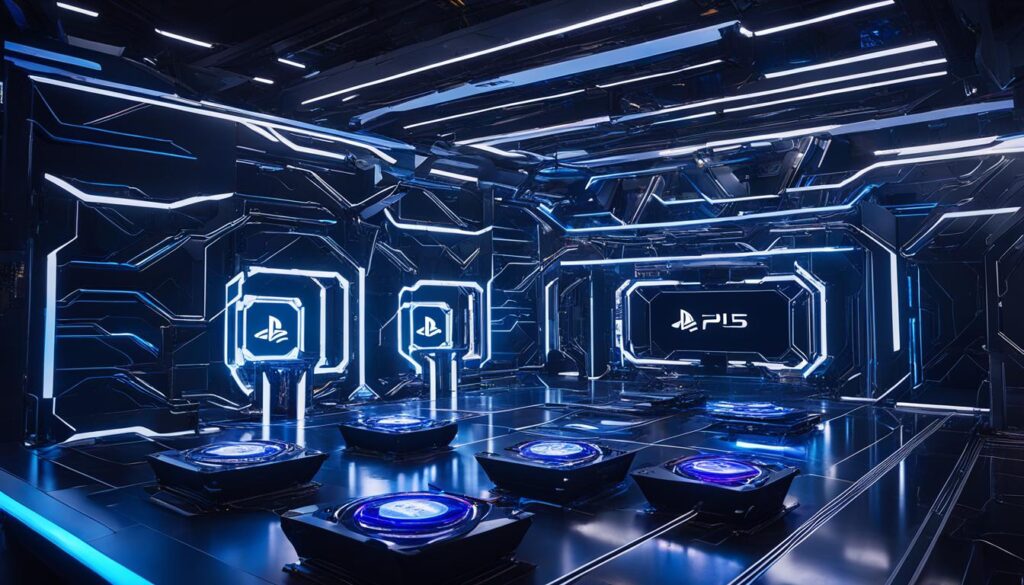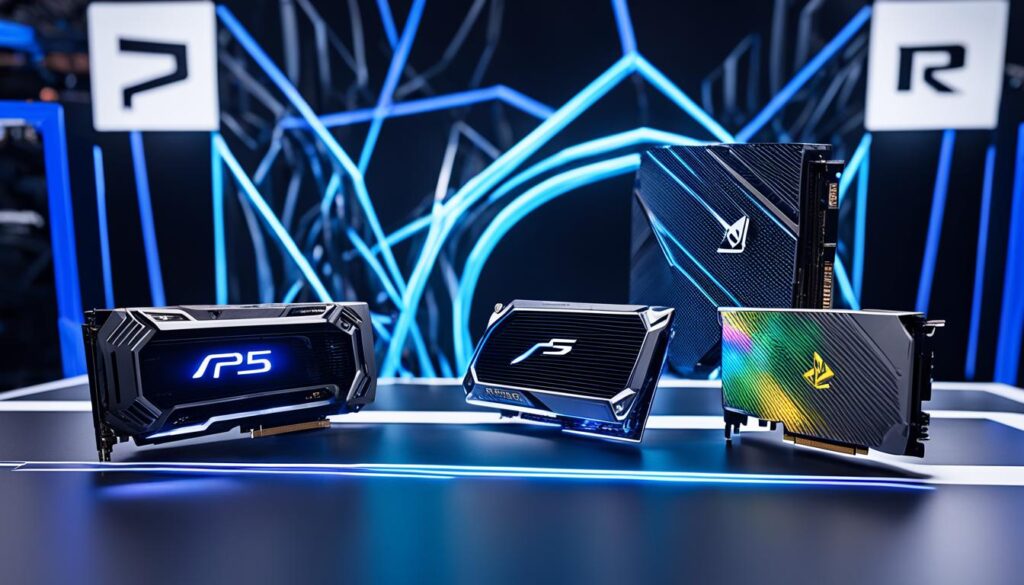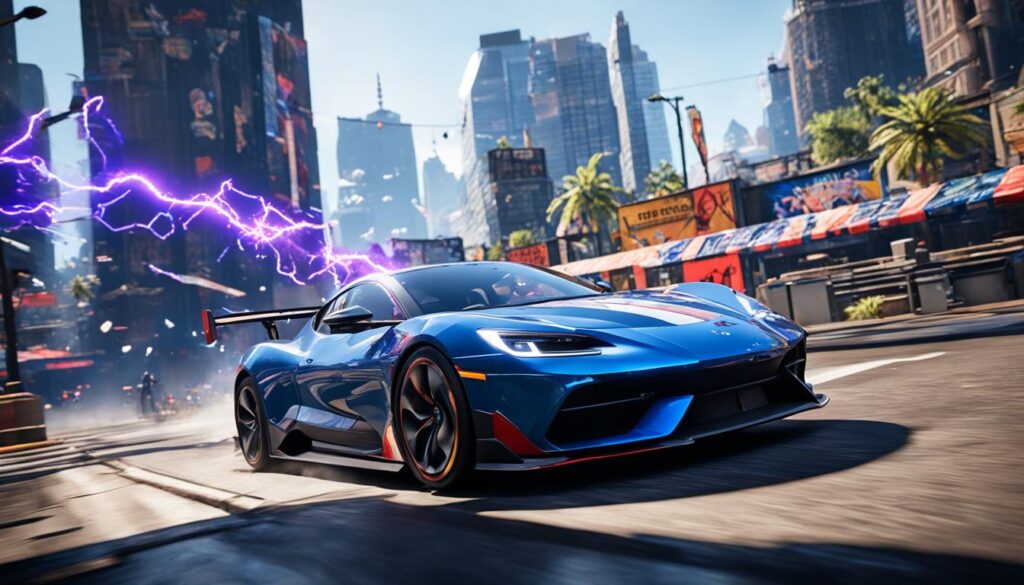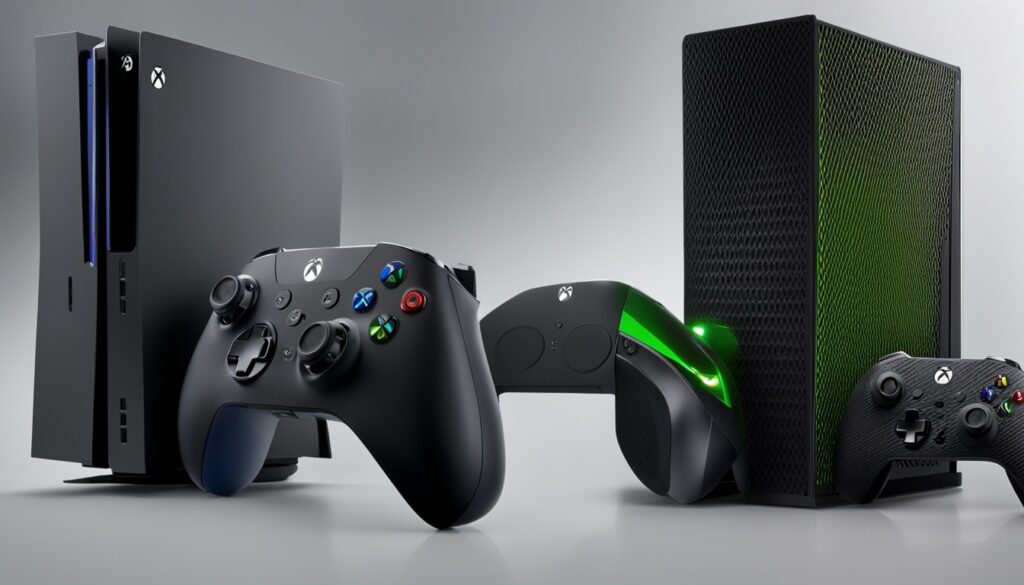The PlayStation 5 (PS5) has redefined the landscape of console gaming with its impressive graphical capabilities. Our exploration starts with understanding the PS5 GPU equivalent, which is pivotal in delivering cutting-edge console graphics performance. Utilizing AMD’s RDNA 2 architecture, the PS5 is designed to push the boundaries of visual fidelity and smooth gameplay.
In this article, we will compare the PS5 graphics card specs to some of the most popular PC GPUs to provide a clearer perspective on how the console stacks up against its PC counterparts. From frame rates to graphical details, we aim to equip gamers with insights into the PS5 vs PC GPU debate, helping us all make informed decisions on our gaming setups.
Introduction to Console Graphics
The realm of console graphics has undergone significant transformations, particularly with the advent of the PS5. As gamers, we’ve witnessed a remarkable leap in visual fidelity, driven by the PS5 GPU features that redefine our gaming experiences. The journey from the earlier generations of consoles to today’s advanced technology illustrates a fascinating gaming technology evolution.
Enhanced graphics capabilities on the PS5 set a new benchmark in the industry. We explore essential aspects such as:
- Improved resolutions, allowing for stunning detail in landscapes and character design.
- Advanced ray tracing technologies, creating dynamic lighting and shadow effects that enhance immersion.
- Higher frame rates, leading to smoother gameplay that elevates the overall gaming experience.
As we delve into the evolution of console graphics, we find that each advancement builds upon the last, paving the way for richer and more engaging interactions within virtual worlds. The PS5 serves as a prime example of how modern gaming technology continues to evolve rapidly, bringing innovations that captivate audiences and transform the way we play.
The Power Behind the PS5 GPU
The power of the PS5 GPU stems from its innovative PS5 GPU architecture, utilizing AMD’s RDNA 2 technology. This architecture boasts 36 compute units that facilitate a graphical output of an impressive 10.28 teraflops. With these specifications, we can expect remarkable clarity and detail in our games.
Incorporating hardware-accelerated ray tracing sets the PS5 apart, allowing for realistic lighting and reflections that enhance the overall gameplay performance. This feature transforms our gaming experiences, bringing immersive environments and lifelike visuals to the forefront.
The efficient memory bandwidth supported by this architecture contributes to faster load times, augmented further by the integrated SSD technology. As we dive into our favorite titles, we witness seamless transitions between scenes while maintaining top-notch performance.
To appreciate how the PS5 specs contribute to an exhilarating gaming journey, let’s summarize its key features in the table below:
| Feature | Specification |
|---|---|
| GPU Architecture | AMD RDNA 2 |
| Compute Units | 36 |
| Graphical Output | 10.28 Teraflops |
| Ray Tracing Support | Yes |
| Integrated SSD Technology | Enabled |

What is the PS5 GPU Equivalent To
When we explore the PS5 GPU equivalent, the conversation often leads us to PC graphics cards. The PS5 stands firm in its GPU specs comparison, matching notable contenders like the RTX 2080 and RTX 3080. Let’s delve deeper into how these units stack up against each other, especially in terms of specifications and architectural design.
Comparing PS5 Graphics Card Specs
The PS5’s GPU features an impressive 16GB of GDDR6 RAM, with a bandwidth reaching 448GB/s. This level of performance aligns closely with high-end GPUs on the market. Below is a table summarizing the key specifications:
| Feature | PS5 GPU | RTX 2080 | RTX 3080 |
|---|---|---|---|
| Memory | 16GB GDDR6 | 8GB GDDR6 | 10GB GDDR6X |
| Memory Bandwidth | 448GB/s | 256GB/s | 760GB/s |
| Architecture | Custom RDNA 2 | Turing | Ampere |
| Ray Tracing | Yes | Yes | Yes |
Importance of GPU Architecture
The unique console GPU architecture of the PS5 plays an essential role in its performance. The custom RDNA 2 design specifically caters to the needs of console gaming, diverging from the more flexible structures seen in PC GPUs. This tailored approach affects everything from power consumption to optimization strategies, providing a distinct gaming experience. Understanding our PS5 GPU comparison offers insight into how these factors contribute to the overall graphics capabilities of the console.
PS5 GPU Performance and Benchmarks
Understanding the PS5 GPU performance requires a close examination of how it handles a variety of popular titles. By looking at various gaming benchmarks, we can see that games optimized for the PS5 deliver remarkable visuals while maintaining smooth gameplay at 4K resolution and up to 60 fps. This performance is particularly impressive when we consider the console versus PC performance landscape.
Analyzing Game Performance
We observe that specific titles showcase impressive capabilities. For instance, games like Demon’s Souls and Ratchet & Clank: Rift Apart exemplify how the PS5 can utilize its GPU effectively. The seamless loading times and high frame rates deliver an immersive experience that competitors find hard to match. Through these analyses, it’s evident how the PS5 manages to stand toe-to-toe with high-end gaming PCs.
Real-world Benchmarks Compared
In comparing the PS5 with certain PC graphics cards, such as the RTX 2080, we find key insights into gaming benchmarks. The following table illustrates the performance of the PS5 against the RTX 2080 across several popular games:
| Game Title | PS5 Frame Rate | RTX 2080 Frame Rate | Resolution |
|---|---|---|---|
| Demon’s Souls | 60 fps | 55 fps | 4K |
| Spider-Man: Miles Morales | 60 fps | 50 fps | 4K |
| Ratchet & Clank: Rift Apart | 60 fps | 58 fps | 4K |
This data reveals that the PS5 GPU performance stands out, especially in optimizing frame rates at high resolutions, which solidifies its place in the current gaming market as a leading console. The competition with PC performance, particularly concerning high-end graphics cards, paints a clear picture of the advancements made in console technology.
PS5 GPU Comparison with PC Graphics Cards
When we analyze the PS5 GPU in relation to popular PC graphics cards like the Nvidia RTX 3080 and RTX 2080, an intriguing gaming graphics comparison emerges. Each option possesses unique strengths that cater to different gaming preferences and technologies.
PS5 vs. RTX 3080
The RTX 3080 stands as a behemoth in the graphics card market, offering extraordinary specs. In terms of raw power, it generally outperforms the PS5. This translates to impressive frame rates and resolutions in demanding titles. Our examination of PS5 GPU benchmarks indicates that while the console excels in exclusives, the RTX 3080 provides higher maximum performance in many mainstream games, particularly when paired with optimized hardware and software setups.
PS5 vs. RTX 2080
In a matchup with the RTX 2080, we see a different dynamic at play. Although the RTX 2080 is a step down in terms of specs, its Deep Learning Super Sampling (DLSS) technology enhances performance, allowing for smoother gameplay at higher resolutions. This leads to an interesting PS5 vs PC GPU narrative, as the console has optimizations tailored for console exclusives. The RTX 2080 may lag in peak performance, but it still provides solid gameplay when DLSS is utilized.

| Feature | PS5 | RTX 3080 | RTX 2080 |
|---|---|---|---|
| GPU Architecture | Custom RDNA 2 | Ampere | Turing |
| VRAM | 16 GB GDDR6 | 10 GB GDDR6X | 8 GB GDDR6 |
| Ray Tracing Support | Yes | Yes | Partial |
| DLSS Support | No | Yes | Yes |
| Target Resolution | 4K | 4K | 1440p/4K |
Ray Tracing Capabilities of PS5 GPU
One of the most remarkable aspects of the PS5 is its implementation of PS5 ray tracing. This technology enhances light simulation, allowing in-game lighting to behave realistically. Traditional lighting methods in games often fall short in achieving true immersion, which is critical for console graphics realism. By utilizing ray tracing, the PS5 allows developers to create environments that mimic the complexities of real-world lighting in a way that was previously challenging.
The PS5 GPU efficiently handles these light simulations in real-time, yielding impressive results in titles that are specifically optimized for this feature. Though the PS5 employs its general compute units for ray tracing, as opposed to dedicated RT cores like those found in Nvidia’s RTX series, it still achieves stunning visuals. This serves as a testament to the PS5’s capability to deliver gaming realism that elevates the player experience beyond mere graphical fidelity.

Optimized titles showcase the PS5’s ray tracing capabilities effectively. Some notable features driven by this technology include:
- Dynamic shadows that change based on light sources
- Reflections that accurately represent the environment
- Realistic atmospheric effects that enhance immersion
As developers increasingly harness the PS5’s ray tracing potential, we can anticipate even greater advancements in console graphics realism. With the evolution of game design, the integration of PS5 ray tracing promises a future where our virtual adventures feel more lifelike than ever before.
| Feature | Traditional Graphics | PS5 Ray Tracing |
|---|---|---|
| Shadow Dynamics | Static and unrealistic | Dynamic and responsive |
| Environmental Reflections | Basic and limited | Accurate and detailed |
| Lighting Effects | Pretend exposure | Real-time simulation |
PS5 vs Xbox Series X GPU: A Comparative Analysis
In our exploration of the PS5 vs Xbox Series X GPU, we delve into the unique specifications and performance metrics each console offers. Both systems utilize custom AMD architectures, showcasing impressive capabilities designed for next-gen gaming. Understanding how these GPUs stack up against each other enhances our perspective on console GPU performance.
Technical Specifications
The PS5 GPU operates at 10.28 teraflops, providing robust graphical performance to tackle the latest gaming titles. On the other hand, the Xbox Series X GPU exceeds this with a performance output of 12 teraflops. Below, we present a detailed comparison of both consoles:
| Specification | PS5 GPU | Xbox Series X GPU |
|---|---|---|
| Teraflops | 10.28 | 12 |
| Architecture | Custom AMD RDNA 2 | Custom AMD RDNA 2 |
| Ray Tracing Support | Yes | Yes |
Performance in Games
Performance in games reveals how these specifications translate into real-world gameplay experiences. In various gaming comparisons, we note that both the PS5 and Xbox Series X deliver remarkable visual fidelity and frame rates across popular titles. Exclusive games often showcase the specific strengths of each platform, with certain titles optimized to leverage the unique features of their respective GPUs. Our analysis indicates nuanced performance advantages depending on the game, reflecting the competitive nature of modern console gaming.

Future-Proofing with the PS5 GPU
In the rapidly evolving arena of gaming, we recognize the necessity of future-proofing, especially regarding the PS5’s GPU. This powerful hardware is adeptly designed to keep pace with emerging gaming technology trends. The architecture of the PS5 ensures it can adapt not only to current requirements but also to the advancements anticipated in next-gen gaming.
Adapting to New Gaming Technologies
The landscape of gaming technology trends continuously shifts, introducing innovations like advanced ray tracing and higher resolution textures. The PS5’s GPU architecture supports advanced rendering techniques, allowing developers to create visually stunning worlds. We see that this adaptability turns the PS5 into a long-term investment for gamers, ensuring it remains relevant as technology progresses.
Game Development Trends
As game makers shift towards utilizing the PS5’s architecture, we expect a surge in titles designed with its capabilities in mind. The commitment to next-gen gaming demands an understanding of the underlying technology. Developers are increasingly leveraging features specific to the PS5 to offer rich, immersive experiences. This trend indicates that future titles will exploit the full potential of the PS5 GPU, solidifying its position in the gaming landscape.
| Gaming Technology Trends | PS5 Features |
|---|---|
| Ray Tracing | Supported |
| 4K Resolution | Supported |
| Spatial Audio | Supported |
| High Frame Rates | Supported |
| SSD Loading Times | Enhanced |
Factors Influencing PS5 GPU Performance
Understanding the various factors that contribute to PS5 GPU performance gives us insight into how we can maximize our gaming experience. Several elements play crucial roles, particularly the impact of SSD technology and effective optimization strategies.
Impact of SSD Technology
The integration of high-speed SSDs dramatically influences gameplay. SSD impact on games includes significantly shorter loading times that enrich the user experience. When game developers leverage this advanced storage technology, they can design larger and more complex gaming environments without compromising speed or performance. This enhancement acts as one of the key PS5 GPU performance factors, ensuring a seamless transition between game worlds that immerses players deeper into the narrative.
Game Optimization Strategies
Effective game optimization strategies are essential for showcasing the full potential of the PS5 GPU. Developers focus on refining graphics and frame rates to enhance visual fidelity and performance. By optimizing game assets and code, studios can fully utilize the console’s capabilities. This kind of console optimization opens the door for smoother gameplay and better graphics, which results in an overall improved gaming experience. We see that meticulous attention to optimization can make a significant difference in PS5 GPU performance factors, elevating a title from good to exceptional.
Conclusion
In summary, the PS5 GPU stands as a monumental achievement in the realm of gaming technology, delivering a level of performance that rivals high-end PC graphics cards. By exploring the PS5 GPU summary, we gain insights into how its architecture functions, allowing us to tap into its full potential. This impressive technology not only enhances our gaming experience but also paves the way for significant advancements in console graphics future.
As we reflect on our gaming performance recap, it’s clear that the PS5 GPU is designed not just for today’s games but also for the ever-evolving landscape of gaming technology. Its capabilities suggest a bright future where visual fidelity and performance will continue to improve. With each technological leap, we can anticipate a richer experience that keeps pace with our gaming desires.
Ultimately, as we move forward in this exciting era of gaming, we can appreciate that the PS5 GPU is more than just a component; it’s a gateway to understanding how console gaming can evolve. Embracing these advancements promises a thrilling journey ahead for all of us in the gaming community.